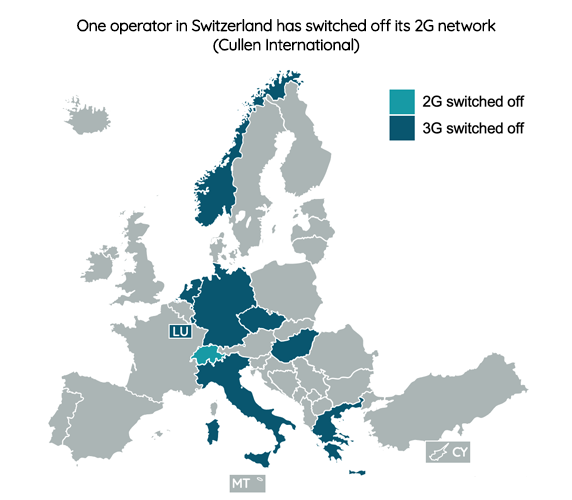In Europe, many mobile network operators (MNOs) have completed or plan to switch off their legacy 2G or 3G networks.
These switch-offs are generally not regulated, but in nearly all cases commercially‑driven, allowing operators to:
- increase the spectrum available for new mobile technologies by re-farming 2G or 3G spectrum for the use of 4G and 5G; and
- generate network cost savings through lower network maintenance costs.
One of the reasons for the continued use of such legacy mobile networks is that they are still used, especially 2G networks, for machine-to-machine (M2M) services, such as smart meters and e-call systems.
Cullen International’s latest European benchmark shows that MNOs in 22 out of the 31 countries researched have completed or have plans to switch off their legacy 2G or 3G networks.
One MNO in Switzerland, Swisscom, switched off its 2G network in April 2021. MNOs' plans to switch off 2G networks exist in eight other European countries.

In only three countries, Czech Republic, Hungary and Italy, did the regulators become involved in whether 2G or 3G networks should be switched off.
Cullen International also has a similar benchmark on the 2G/3G switch-off in the MENA region.
To access the full benchmark, please click on “Access the full content” - or on “Request Access”, in case you are not subscribed to our European Telecoms Service.
more news
06 June 25
Update on digital services taxes in Europe
Our latest benchmark offers an overview of taxes adopted or proposed on digital services across Europe.
05 June 25
New ecodesign requirements for smartphones and tablets to apply this month
From 20 June 2025, all new smartphones and tablets must meet new EU ecodesign requirements covering reparability, software updates, durability and battery life. Our new Tracker provides a concise description of the EU ecodesign rules and puts them into context.
28 May 25
One in three geographical surveys in Europe includes forecasts
The European Electronic Communications Code requires national regulators to conduct periodic geographical surveys of broadband network coverage. Our new benchmark across 30 European countries provides an overview of the geographical surveys and whether they include forecasts.